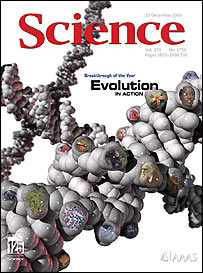Avi Blizovsky

The scientific journal Science placed at the top of the list of scientific breakthroughs of 2005 the study that revealed how evolution works. The list of "breakthroughs of the year" includes the decoding of the chimpanzee genome sequence, the re-creation of the 1918 influenza virus in the laboratory, and a study of black-headed birds from Europe that demonstrated how two populations can become two separate species.
"If the debates surrounding the nature of evolution affected us at all, it was in the sense of recognizing that scientists are going to take for granted that evolution forms the basis of modern biology." said Colin Norman, the news editor of Science, who added that the choice was based on the objective value of the studies and not to serve as a tool in the fight against the theory of intelligent design. "The debates about intelligent planning only make us aware of the issue a little more".
The followers of intelligent design claim that most of the features of the universe and in particular those of living beings are too complex to be the result of natural selection. Instead, the "theory" claims that they must have been designed by an intelligent supernatural force. Studies. Norman says he hopes the selection will send a message to scientists and the public: "Evolution is not just something that scientists study as an esoteric detail." added "It has important implications for public health and our understanding of who we are."
For example, researchers believe that the study that examined the genetic difference between humans and chimpanzees could point to the basis of many diseases and the study of the behavior of the 1918 influenza virus may help us fight the next expected wave of the bird flu epidemic. "Recent advances in evolutionary biology have improved the sharpness of our understanding of genetics," said Dr. Mike Ritchie, from the School of Biology at the University of St. Andrews in the UK. "When scientists find a gene that they think is involved in a specific phenomenon, I can now go and see how it evolved in 12 different species of flies, because we have the genomes of all these creatures online."
In 2005, the great complexity in which evolution works was revealed," wrote the editors in their reasons for choosing the study. "Ironically, this year certain parts of American society also tried to deny the most basic facts of this Torah."
Don Kennedy, the editor-in-chief of the journal, recognized the connection between the choice of evolution as a breakthrough and the growing preoccupation with the theory of intelligent design. This theory holds that certain parts of nature are so complex that they had to be created by some entity, and could not have been created as a result of natural and random selection, as Darwin claimed.
According to Kennedy, one of the reasons the research supporting evolution was chosen as this year's breakthrough is that it is a "hot topic", but he emphasized that a lot of research justified the selection.
Opponents of the theory of intelligent design, including many scientists, claim that it is a disguised version of the theory of creation - the belief that God created the world as described in the book of Genesis - which the US Supreme Court banned from being taught in schools.
"I think what angers scientists is the idea that the theory of intelligent design belongs to the same world of concepts of scientific analysis," Kennedy said in a telephone interview. "This is an assumption that cannot be tested." According to him, an idea rooted in spiritual belief such as intelligent design cannot be disproved.
Mission Titan
In the field of space, several robotic missions were chosen, including that of the Huygens spacecraft that landed on Saturn's moon Titan on January 14 and whose research results that day continue to be published. It was the spacecraft that landed at the greatest distance from Earth and transmitted a wide range of data despite losing one of the two radio channels. The information gathered by Huygens during his descent through Titan's thick atmosphere and eventual landing on the icy surface shed light on a world that might have looked like Earth did 4.6 billion years ago.
Full list
• The winner in the field "evolution in action" - paving the gardens and diligent observation in the field illuminated the complexity of the action of evolution.
• In second place: planetary attack - the Huygens spacecraft landed on Saturn's moon Titan on Saturday. She was accompanied by a fleet of other robots, including NASA's Deep Impact, which blasted a hole in a comet.
• The molecular biologists have isolated some of the genes responsible for the abundance of colors of the spring flowers.
• Satellites and ground telescopes shed light on the violent behavior of neutron stars; Compact stars the size of a city where matter is compressed to an extreme state.
• The brain: researchers have gathered clues about the mechanisms of disorders such as schizophrenia, dyslexia and Tourette's syndrome.
• The Solar System: Comparing rocks from Earth and space has forced scientists to discard old theories about how the planets formed
• The brain: Scientists got a closer look at the molecular structure of potassium channels that act as electrical gates.
• Climate change: More and more evidence about the impact of human activity in regards to global warming was presented this year.
• Systems biology. Molecular biologists look for insights in engineering in order to understand the behavior of complex systems
• Giant engineering: after 18 months of debate, the international experimental thermonuclear generator won a home - Cadrash in France.
https://www.hayadan.org.il/BuildaGate4/general2/data_card.php?Cat=~~~348100662~~~37&SiteName=hayadan
